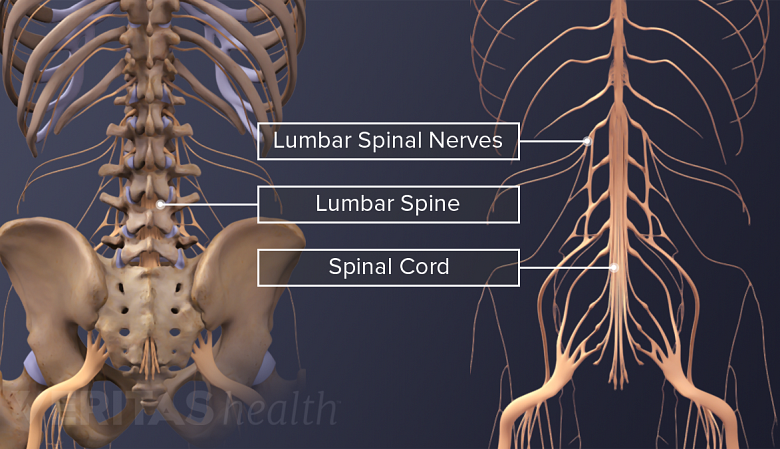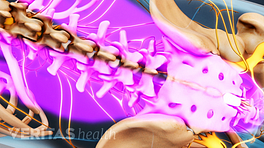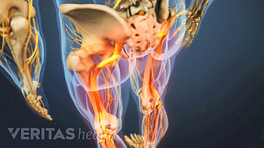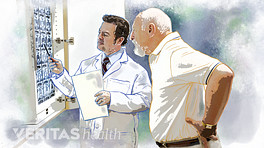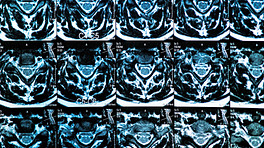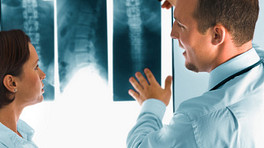Discogram performed by an experienced practitioner is relatively safe. The potential complications are rare and can be similar to the risks from any form of spinal injection for treating or diagnosing back pain.
In This Article:
- Lumbar Discography for Back Pain Diagnosis
- Lumbar Discogram Procedure
- Potential Side Effects and Risks of Discogram
Serious Adverse Reactions After Lumbar Discogram
Rarely, while performing a discogram, the disc, nearby nerves, and/or spinal cord may be inadvertently injured, or the patient may experience an allergic reaction to one or more contents of the injection solution. These rare adverse events may include but are not limited to:
Discitis
An infection of the disc, or discitis, may occur if bacteria from the skin enter the disc through the needle. Following a sterile procedure, the double-needle technique, and administering preprocedural prophylactic antibiotics may help prevent this risk. 1 Peh W. Provocative discography: Current status. Biomed Imaging Interv J. 2005;1(1):e2. doi:10.2349/biij.1.1.e2 Available from: https://www.ncbi.nlm.nih.gov/pmc/articles/PMC3097593/
Nerve damage
Accidental nerve or spinal cord injury is a potential complication of discogram.
The needle may injure a nearby nerve causing transient or long-term damage, resulting in reduced or impaired nerve function and/or neural pain. 1 Peh W. Provocative discography: Current status. Biomed Imaging Interv J. 2005;1(1):e2. doi:10.2349/biij.1.1.e2 Available from: https://www.ncbi.nlm.nih.gov/pmc/articles/PMC3097593/
Spinal headache
Needle puncture of the membranes covering the spinal cord may cause a leak of spinal fluid, leading to a spinal headache. 1 Peh W. Provocative discography: Current status. Biomed Imaging Interv J. 2005;1(1):e2. doi:10.2349/biij.1.1.e2 Available from: https://www.ncbi.nlm.nih.gov/pmc/articles/PMC3097593/ Spinal headaches may begin within 2-3 days after the procedure and typically resolve with rest and fluid intake. A procedure called “epidural blood patch,” where blood is withdrawn from the patient's arm and injected into the epidural space in the back (to create a blood patch) may help control the headache symptoms. This procedure places pressure over the site that is leaking spinal fluid to stop the leak and in turn resolve the headache.
Allergic reaction to the dye
Adverse reactions to the injected dye are rare and usually mild. Symptoms may include itching, rash, sneezing, and/or nausea.
Other rare but possible complications may include needle breakage or spinal cord injury, bleeding, or infection. 1 Peh W. Provocative discography: Current status. Biomed Imaging Interv J. 2005;1(1):e2. doi:10.2349/biij.1.1.e2 Available from: https://www.ncbi.nlm.nih.gov/pmc/articles/PMC3097593/
When to Call a Doctor
Any troublesome symptom or sign after the discogram procedure must be discussed with a doctor. If fever over 101 °F, chills, and/or severe (or delayed) pain occurs, it may indicate an infection and must be evaluated by a doctor immediately.
Discography may be beneficial in identifying true disc-related pain and setting the foundation for surgical treatment of long-term back pain or sciatica unresolved by nonsurgical treatments. A positive discogram and abnormal imaging on a magnetic resonance imaging (MRI) or computed tomography (CT) scan of the same disc may help confirm disc pain and improve the surgical outcome of the treated spinal segment. Future studies with a more diverse inclusion of patients with specific back conditions may help provide a better understanding of the specific uses of discography.
- 1 Peh W. Provocative discography: Current status. Biomed Imaging Interv J. 2005;1(1):e2. doi:10.2349/biij.1.1.e2 Available from: https://www.ncbi.nlm.nih.gov/pmc/articles/PMC3097593/
